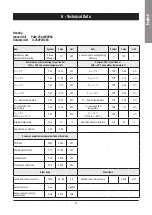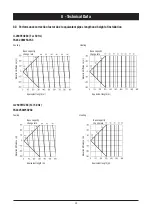
41
English
11 - Dismantling, Demolition and Scrapping
DANGER
During the draining of the refrigeration
circuits, do not let the refrigerant overflow in
the surrounding atmosphere.
The circuit must be drained using suitable
recovery equipment.
For the disposal, contact the competent authority for information.
Unless otherwise specified, the maintenance operations listed below
may be carried out by any trained maintenance operator.
11.1 Generalities
Open each line that supplies the unit, including the ones of control
circuits. Make sure that all disconnecting switches are secured
in the off position. The power cables can be disconnected and
disassembled. Refer to Chapter 4 for the position of connection
points.
Remove all the refrigerant from the refrigeration circuits of the
unit and store it in suitable containers, using a recovery unit. If its
characteristics have remain the same, the refrigerant can be used
again. Contact a competent authority to obtain information about
disposal. In
NO
event shall the refrigerant be discharged into the
atmosphere. The oil in each refrigeration circuit must be drained and
collected into a suitable container; then it shall be disposed of in
conformity with local regulations that apply to the disposal of waste
lubricants. Any oil spillage must be recovered and disposed of in a
like manner.
Isolate the unit’s heat exchangers from the external hydraulic circuits
and drain the heat exchange sections of the plant.
DANGER
If no shutoff valves have been provided, it may
be necessary to drain the whole plant.
If a glycol solution or a similar fluid has been
used in the hydraulic circuits, or if chemical
additives have been added to the circulating
water, the circulating fluid MUST be drained in
a proper way.
For NO reason shall a circuit containing
glycol water mixture or a similar solution be
discharged directly into the drains or surface
waters.
Note that this unit is not specified to work with
a glycol solution
After draining operations, the piping of the hydraulic networks can be
disconnected and disassembled.
Once they have been disconnected as specified, the packaged units
can be disassembled in a single piece. First of all, disassemble
the anchoring screws and then lift the unit from the position of
installation, and hook it to the lifting points provided, using suitable
lifting equipment.
To this end, refer to Chapter 4 for the installation of these appliances,
to Chapter 8
for their weights and Chapter 3 for handling.
The units that, once disconnected, cannot be removed in a single
piece, must be dismantled on site; in this case, be very careful with
the weight and handling of each component.
It is always advisable to dismantle the units following the installation
steps, but in reverse.
DANGER
Some residues of oil, glycol water mixture or
similar solutions may remain in certain parts
of the unit. These residues must be recovered
and disposed of according to the procedures
specified above.
It is very important to ensure that, while a component of the unit is
being removed, all the others are properly supported.
DANGER
Use only lifting means of adequate capacity.
Once disassembled, the components of the unit can be disposed of
in conformity with current regulations.
11.2 RAEE Directive (only EU)
•
The RAEE Directive requires that the disposal and
recycling of electrical and electronic equipment
must be handled through a special collection, in
appropriate centers, separate from that used for the
disposal of mixed urban waste.
•
The user has the obligation not to dispose of the
equipment at the end of the useful life as municipal
waste, but to send it to a special collection center.
•
The units covered by the RAEE Directive are marked
with the symbol shown above.
•
The potential effects on the environment and human
health are detailed in this manual.
Содержание PAW-200W5APAC
Страница 2: ......
Страница 28: ...26 6 Control 6 3 WHE Wiring Diagram ...
Страница 36: ...34 8 Technical Data 8 6 Space Requirements mm min 40 min 1000 min 300 min 100 ...


































